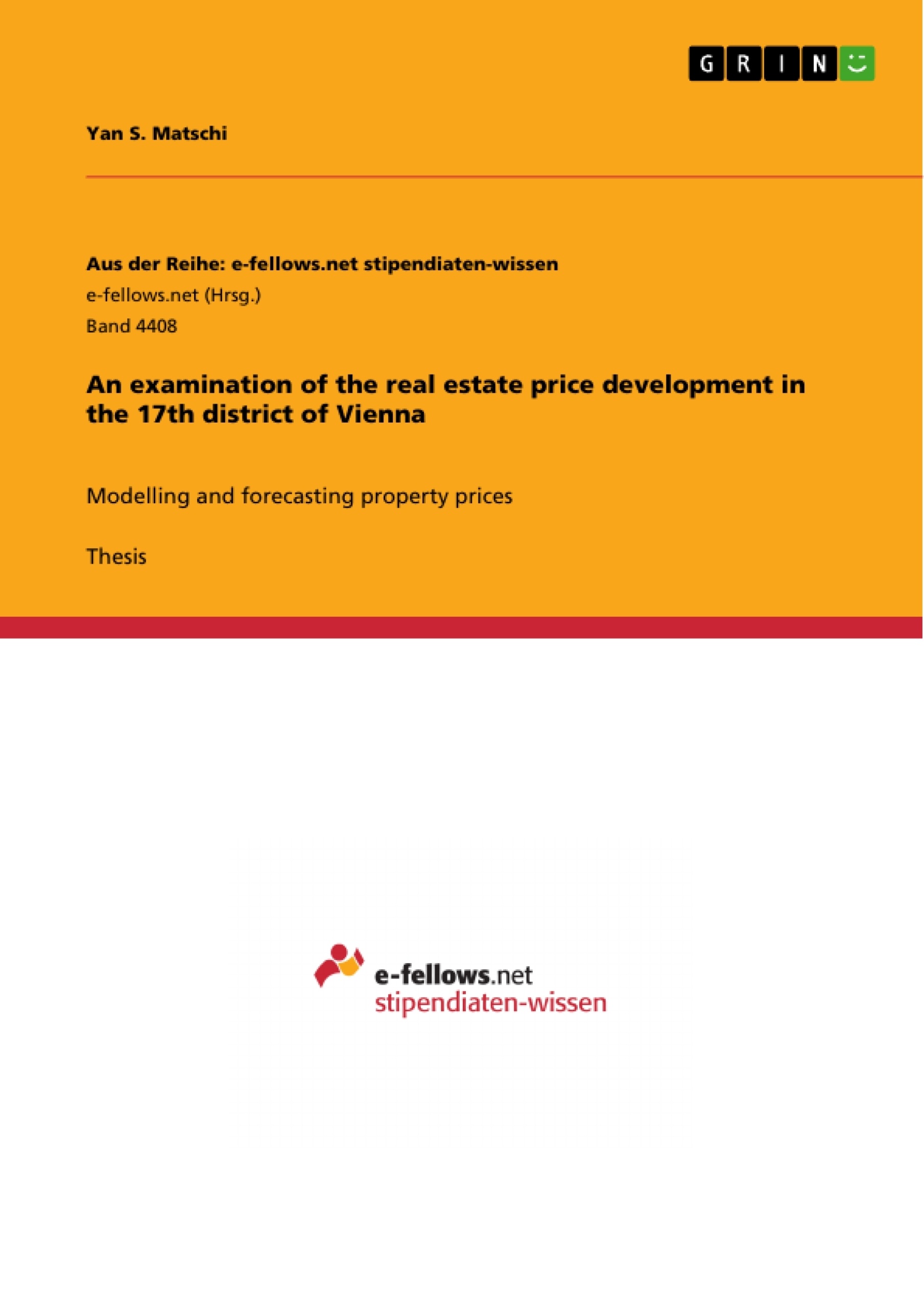House prices are some of the few financial goods that are modelled only to a limited extent in microeconomic systems, despite the heterogeneity of real estate. Usually, no distinction is made between the type of property. This paper addresses this gap by examining property prices of privately-owned apartments in the 17th district of Vienna. First, price indices are created from land register sales data using various models to determine the current price level. Factors influencing real estate prices are identified and Machine Learning models are used to forecast the price development in the area of interest. Finally, the broader implications at the micro- and macroeconomic scale are discussed.
Inhaltsverzeichnis (Table of Contents)
- Abstract
- Table of contents
- Preface
- 1 Introduction
- 2 Methodology for modelling current and future property prices in the 17th district of Vienna
- 2.1 Methods of calculating the current price level of privately-owned apartments
- 2.1.1 Price level determination through plain time series (TS)
- 2.1.2 Price level determination through random forest algorithm (RF)
- 2.1.3 Price level determination through hedonic models
- 2.2 Approach to forecasting price level developments
- 2.2.1 Random forest
- 2.2.2 eXtreme Gradient Boosting (XGBoost)
- 2.2.3 Support vector machines/regression (SVM)
- 2.2.4 Prophet (with XGBoost errors)
- 2.2.5 Auto regressive integrated moving average (ARIMA) (with XGBoost errors)
- 2.2.6 Linear Model (only in TS)
- 2.1 Methods of calculating the current price level of privately-owned apartments
- 3 Determining influencing factors
- 3.1 External/macroeconomic influencing factors
- 3.1.1 Supply and demand
- 3.1.1.1 The population development
- 3.1.1.2 Purchasing power
- 3.1.1.3 Rate of inflation
- 3.1.1.4 Interest rates
- 3.1.1.5 Improvement of infrastructure
- 3.1.2 Transaction volume
- 3.1.1 Supply and demand
- 3.2 Internal influencing factors
- 3.2.1 Location factors
- 3.2.2 Useable area
- 3.2.3 Sum of loggia areas
- 3.2.4 Noise
- 3.3 Narratives and experience
- 3.1 External/macroeconomic influencing factors
- 4 Results
- 4.1 Results of modelling the current price level of privately owned apartments in the 17th district of Vienna
- 4.1.1 Plain time series analysis
- 4.1.2 Random forest algorithm
- 4.1.3 Hedonic model
- 4.1.4 A data analysis of estimates from Austrian institutions
- 4.2 Forecasting results
- 4.2.1 Price level forecast through regular time series
- 4.2.2 Price level forecast through random forest regression
- 4.1 Results of modelling the current price level of privately owned apartments in the 17th district of Vienna
- 5 Analysis
- 5.1 Social and economic implications
- 5.1.1 Effects on the individual
- 5.1.2 Effects on the national economy
- 5.1 Social and economic implications
Zielsetzung und Themenschwerpunkte (Objectives and Key Themes)
The paper aims to analyze the price development of privately-owned apartments in the 17th district of Vienna using various modelling and forecasting techniques. The research focuses on identifying influential factors and predicting future price trends.
- Modelling and forecasting real estate prices
- Analyzing influencing factors on real estate prices
- Examining the price level of privately-owned apartments in Vienna's 17th district
- Exploring the social and economic implications of real estate price development
- Utilizing machine learning models for forecasting
Zusammenfassung der Kapitel (Chapter Summaries)
- Chapter 1: Introduction Provides a general overview of the research topic and its significance, outlining the gap in existing research on real estate price modelling.
- Chapter 2: Methodology Describes the methods used to model current and future property prices in the 17th district of Vienna. This includes various approaches for calculating the current price level, such as plain time series analysis, random forest algorithms, and hedonic models. The chapter also explains the different forecasting models employed, including random forest, XGBoost, SVM, Prophet, ARIMA, and linear models.
- Chapter 3: Determining Influencing Factors Identifies the key external and internal factors that influence real estate prices. External factors include macroeconomic indicators like population development, purchasing power, inflation, interest rates, and infrastructure improvements. Internal factors encompass location characteristics, usable area, loggia areas, and noise levels. This chapter also explores the role of narratives and experience in shaping real estate perceptions and pricing.
- Chapter 4: Results Presents the findings of the modelling and forecasting exercises. It analyzes the results of different methods for determining the current price level, including plain time series analysis, random forest, and hedonic models. The chapter also showcases the price level forecasts obtained through various models, including regular time series, random forest regression, and other predictive approaches.
- Chapter 5: Analysis Discusses the social and economic implications of the observed price developments. It explores the effects of real estate price fluctuations on individuals and the national economy.
Schlüsselwörter (Keywords)
This paper examines real estate price development, focusing on privately-owned apartments in Vienna's 17th district. Key concepts include price modelling, forecasting, machine learning, influencing factors, social and economic implications, and data analysis.
- Quote paper
- Yan S. Matschi (Author), 2023, An examination of the real estate price development in the 17th district of Vienna, Munich, GRIN Verlag, https://www.hausarbeiten.de/document/1460000


